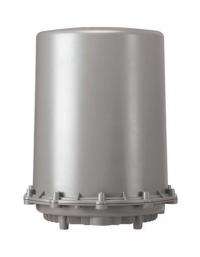This image provided by Verizon shows an antenna that would be installed on the outside wall of a home that uses Verizon Wireless' new HomeFusion service. The service is designed for use in homes that can't get DSL or cable. The service requires the installation of the cylindrical antenna, about the size of a 5-gallon bucket. (AP Photo/Verizon)
Verizon Wireless on Tuesday announced a version of its wireless broadband service that's designed for use in rural and remote homes that can't get DSL or cable.
The service, called HomeFusion, could also appeal to some households where DSL is the only fixed-line option, since it's faster than most DSL services.
HomeFusion could provide potent competition for satellite broadband providers, which are often "providers of last resort" for rural homes.
The service requires the installation of a cylindrical antenna, about the size of a 5-gallon bucket, on an outside wall. The hardware costs $200, but the work is free.
Service starts at $60 per month for 10 gigabytes of data. That's enough of a monthly data allotment to download the complete works of Shakespeare 2,000 times, or to watch about 10 hours of HD-quality video using an Internet streaming service such as Netflix.
Dallas, Nashville, Tenn., and Birmingham, Ala., will be the first areas to get the service, later this month. By the end of the year, Verizon hopes to provide it everywhere it has coverage with its new "LTE" wireless network.
Verizon cites the same speeds for HomeFusion as for LTE data sticks: 5 to 12 megabits per second for downloads, and 2 to 5 megabits for uploads. However, LTE users frequently report much higher speeds, ranging up to 70 megabits per second for downloads.
By comparison, DSL service provided by Verizon Communications Inc., the fixed-line phone company that owns most of Verizon Wireless, provides download speeds up to 7 megabits per second in most areas.
Verizon's DSL service doesn't limit the data usage like HomeFusion does. The average U.S. and Canadian household usage of 22.7 gigabytes in September, as reported by Sandvine Inc.
However, a few heavy-using households skew the figure: the median usage was just 5.8 gigabytes. In other words, half of all broadband households used 5.8 gigabytes or less, and would have some headroom with a 10-gigabyte plan.
The 10-gigabyte plan would limit Internet movie watching to a few hours per month, and limit downloads of big software packages as well.
Verizon will sell step-up plans with 20 gigabytes of data for $90 per month and 30 gigabytes for $120 per month. It charges $10 per gigabyte of overage on any of the plans.
The $60 and $90 plans provide one-third more data per month than corresponding plans sold by ViaSat Inc. for its Exede satellite broadband service.
Wireless broadband for home use is not a new idea. Clearwire Corp. sells a similar service, without an external antenna, but has limited rural coverage. A number of smaller companies limit their service to one community.
©2012 The Associated Press. All rights reserved. This material may not be published, broadcast, rewritten or redistributed.



















